YAMAHA XL 1200 2001 Workshop Manual
Manufacturer: YAMAHA, Model Year: 2001, Model line: XL 1200, Model: YAMAHA XL 1200 2001Pages: 131, PDF Size: 8.12 MB
Page 51 of 131
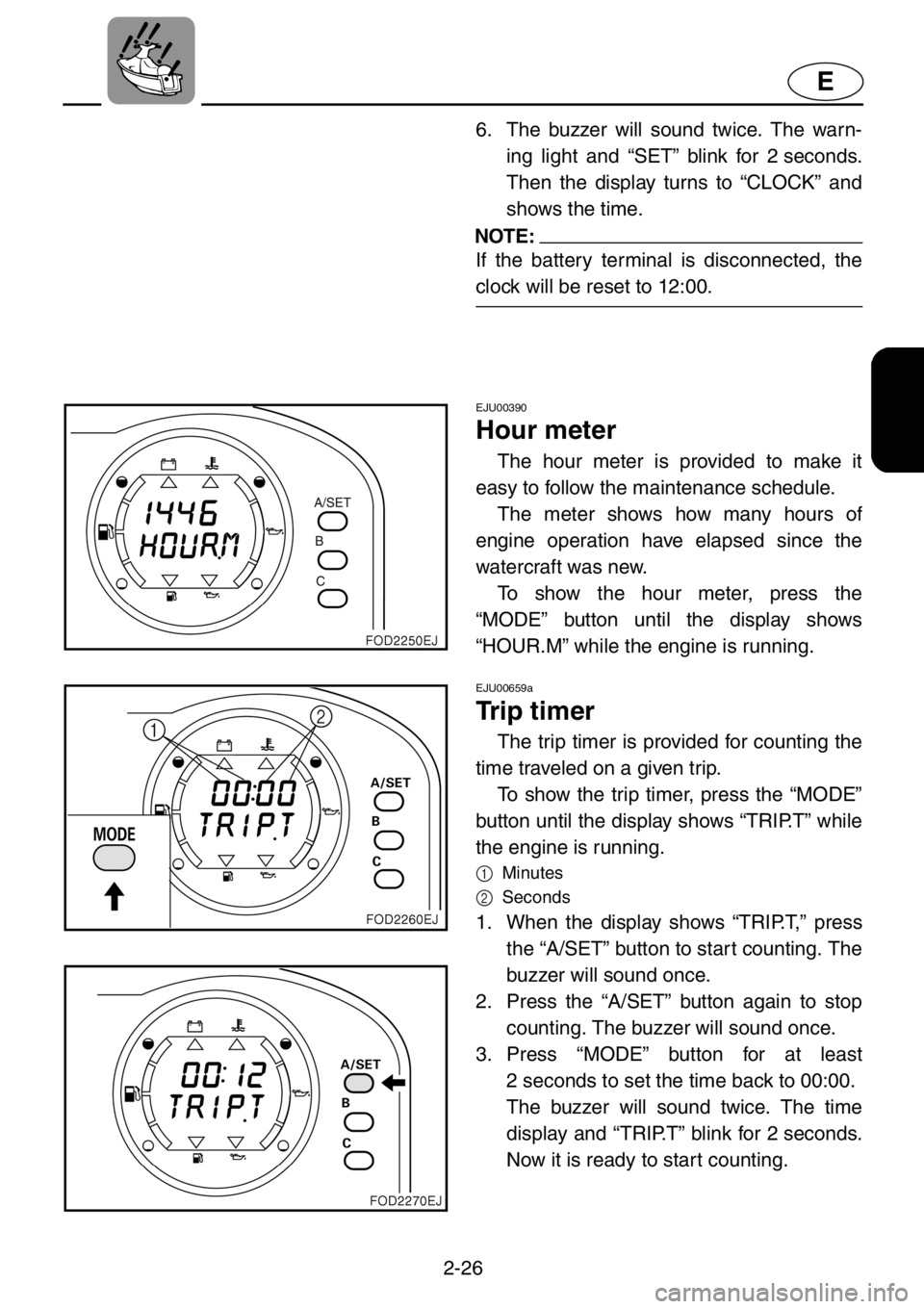
2-26
E
6. The buzzer will sound twice. The warn-
ing light and “SET” blink for 2 seconds.
Then the display turns to “CLOCK” and
shows the time.
NOTE:
If the battery terminal is disconnected, the
clock will be reset to 12:00.
EJU00390
Hour meter
The hour meter is provided to make it
easy to follow the maintenance schedule.
The meter shows how many hours of
engine operation have elapsed since the
watercraft was new.
To show the hour meter, press the
“MODE” button until the display shows
“HOUR.M” while the engine is running.
EJU00659a
Trip timer
The trip timer is provided for counting the
time traveled on a given trip.
To show the trip timer, press the “MODE”
button until the display shows “TRIP.T” while
the engine is running.
1
Minutes
2
Seconds
1. When the display shows “TRIP.T,” press
the “A/SET” button to start counting. The
buzzer will sound once.
2. Press the “A/SET” button again to stop
counting. The buzzer will sound once.
3. Press “MODE” button for at least
2 seconds to set the time back to 00:00.
The buzzer will sound twice. The time
display and “TRIP.T” blink for 2 seconds.
Now it is ready to start counting.
Page 52 of 131
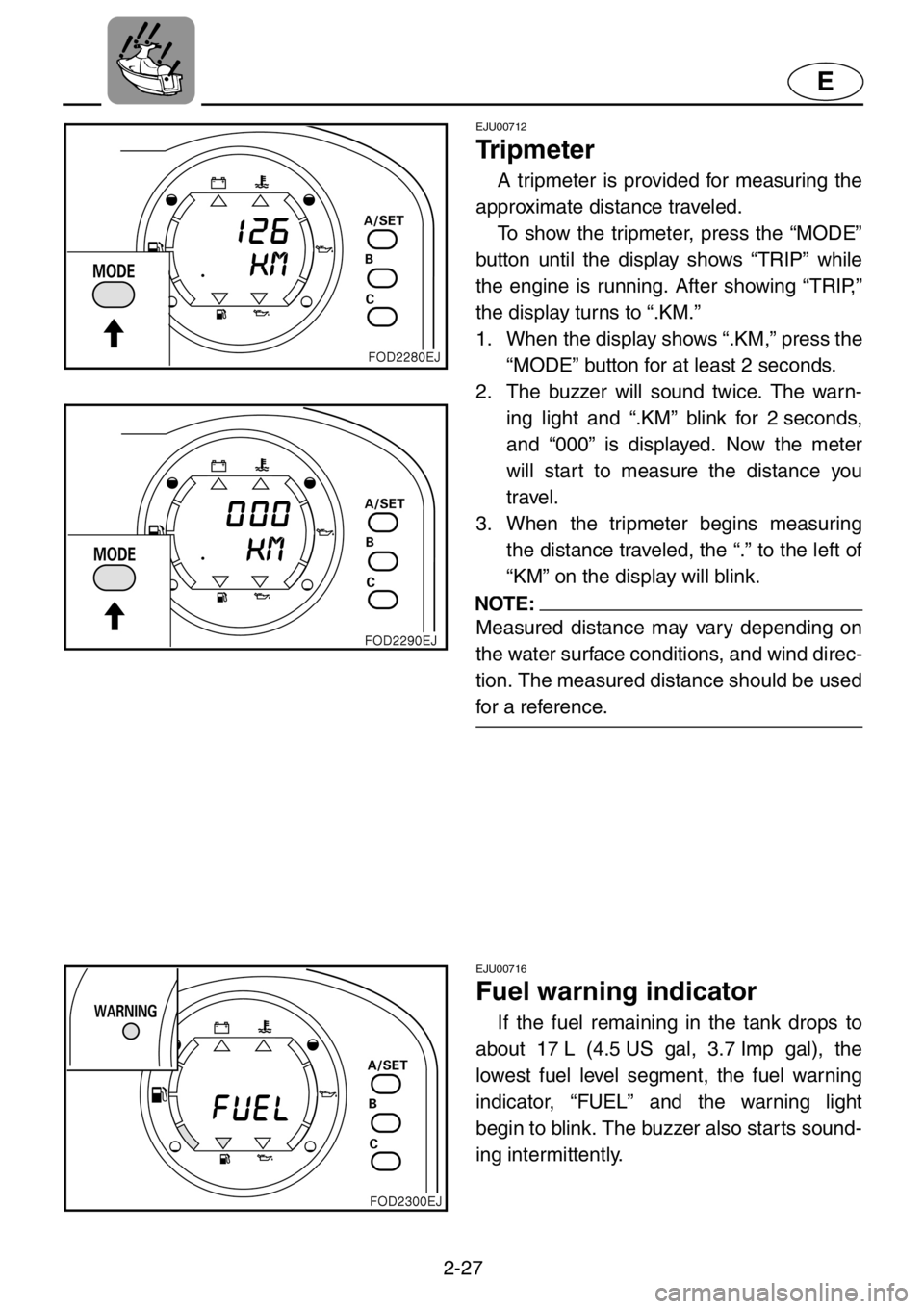
2-27
E
EJU00712
Tr i p m e t e r
A tripmeter is provided for measuring the
approximate distance traveled.
To show the tripmeter, press the “MODE”
button until the display shows “TRIP” while
the engine is running. After showing “TRIP,”
the display turns to “.KM.”
1. When the display shows “.KM,” press the
“MODE” button for at least 2 seconds.
2. The buzzer will sound twice. The warn-
ing light and “.KM” blink for 2 seconds,
and “000” is displayed. Now the meter
will start to measure the distance you
travel.
3. When the tripmeter begins measuring
the distance traveled, the “.” to the left of
“KM” on the display will blink.
NOTE:
Measured distance may vary depending on
the water surface conditions, and wind direc-
tion. The measured distance should be used
for a reference.
EJU00716
Fuel warning indicator
If the fuel remaining in the tank drops to
about 17 L (4.5 US gal, 3.7 Imp gal), the
lowest fuel level segment, the fuel warning
indicator, “FUEL” and the warning light
begin to blink. The buzzer also starts sound-
ing intermittently.
Page 53 of 131
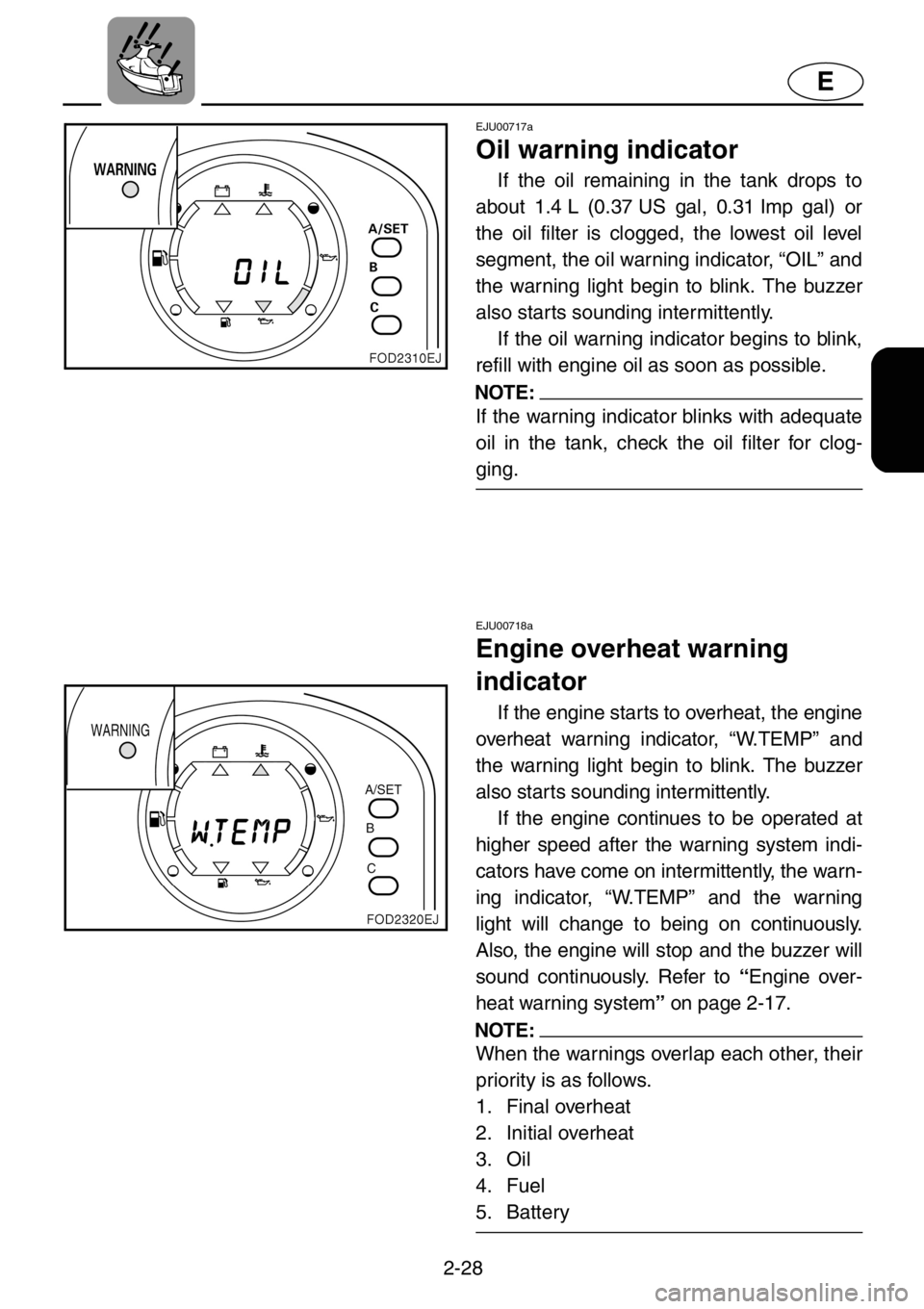
2-28
E
EJU00717a
Oil warning indicator
If the oil remaining in the tank drops to
about 1.4 L (0.37 US gal, 0.31 Imp gal) or
the oil filter is clogged, the lowest oil level
segment, the oil warning indicator, “OIL” and
the warning light begin to blink. The buzzer
also starts sounding intermittently.
If the oil warning indicator begins to blink,
refill with engine oil as soon as possible.
NOTE:
If the warning indicator blinks with adequate
oil in the tank, check the oil filter for clog-
ging.
EJU00718a
Engine overheat warning
indicator
If the engine starts to overheat, the engine
overheat warning indicator, “W.TEMP” and
the warning light begin to blink. The buzzer
also starts sounding intermittently.
If the engine continues to be operated at
higher speed after the warning system indi-
cators have come on intermittently, the warn-
ing indicator, “W.TEMP” and the warning
light will change to being on continuously.
Also, the engine will stop and the buzzer will
sound continuously. Refer to “Engine over-
heat warning system” on page 2-17.
NOTE:
When the warnings overlap each other, their
priority is as follows.
1. Final overheat
2. Initial overheat
3. Oil
4. Fuel
5. Battery
Page 54 of 131
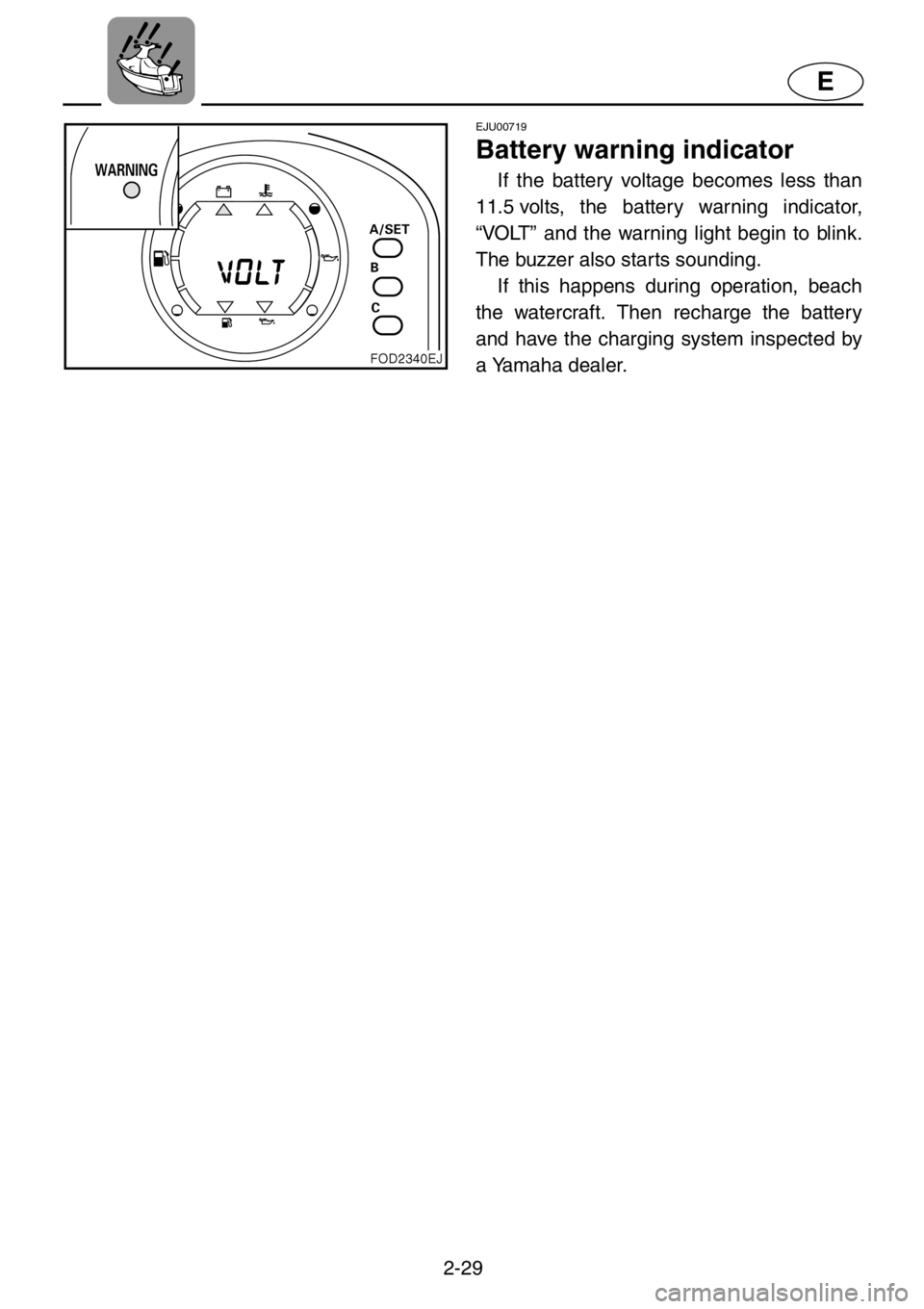
2-29
E
EJU00719
Battery warning indicator
If the battery voltage becomes less than
11.5 volts, the battery warning indicator,
“VOLT” and the warning light begin to blink.
The buzzer also starts sounding.
If this happens during operation, beach
the watercraft. Then recharge the battery
and have the charging system inspected by
a Yamaha dealer.
Page 55 of 131
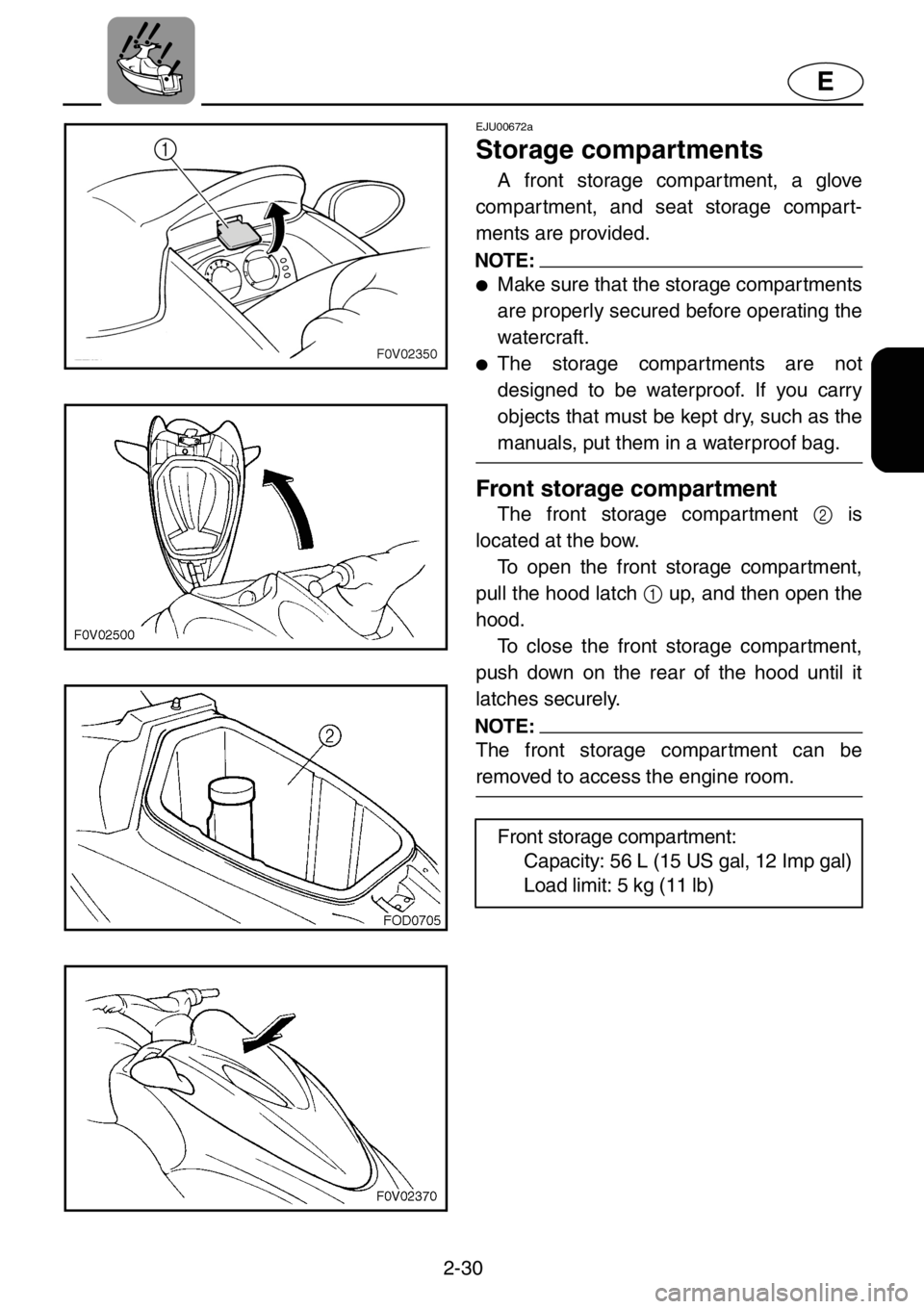
2-30
E
EJU00672a
Storage compartments
A front storage compartment, a glove
compartment, and seat storage compart-
ments are provided.
NOTE:
●Make sure that the storage compartments
are properly secured before operating the
watercraft.
●The storage compartments are not
designed to be waterproof. If you carry
objects that must be kept dry, such as the
manuals, put them in a waterproof bag.
Front storage compartment
The front storage compartment 2 is
located at the bow.
To open the front storage compartment,
pull the hood latch 1 up, and then open the
hood.
To close the front storage compartment,
push down on the rear of the hood until it
latches securely.
NOTE:
The front storage compartment can be
removed to access the engine room.
Front storage compartment:
Capacity: 56 L (15 US gal, 12 Imp gal)
Load limit: 5 kg (11 lb)
Page 56 of 131
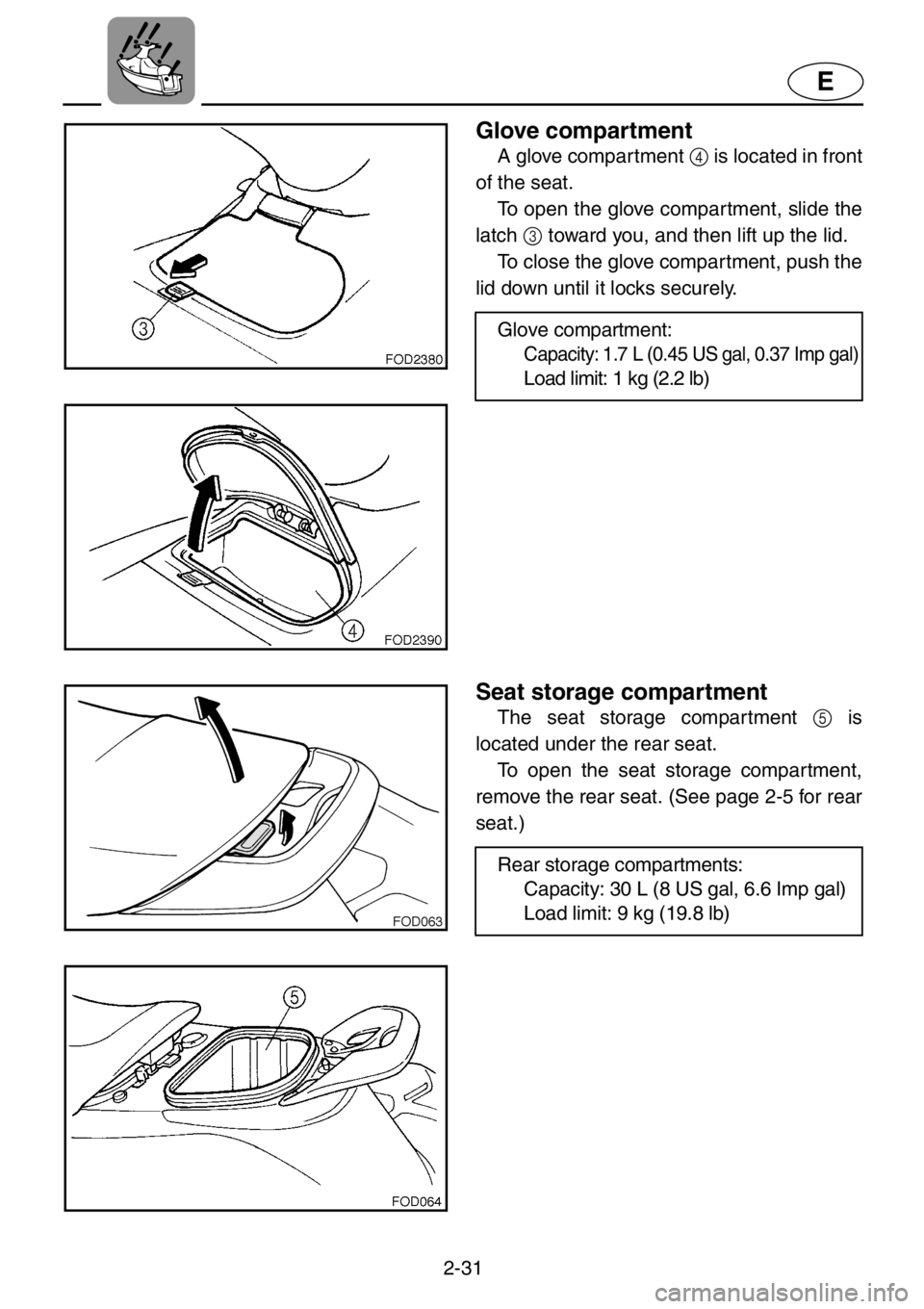
2-31
E
Glove compartment
A glove compartment 4 is located in front
of the seat.
To open the glove compartment, slide the
latch 3 toward you, and then lift up the lid.
To close the glove compartment, push the
lid down until it locks securely.
Glove compartment:
Capacity: 1.7 L (0.45 US gal, 0.37 Imp gal)
Load limit: 1 kg (2.2 lb)
Seat storage compartment
The seat storage compartment 5 is
located under the rear seat.
To open the seat storage compartment,
remove the rear seat. (See page 2-5 for rear
seat.)
Rear storage compartments:
Capacity: 30 L (8 US gal, 6.6 Imp gal)
Load limit: 9 kg (19.8 lb)
Page 57 of 131
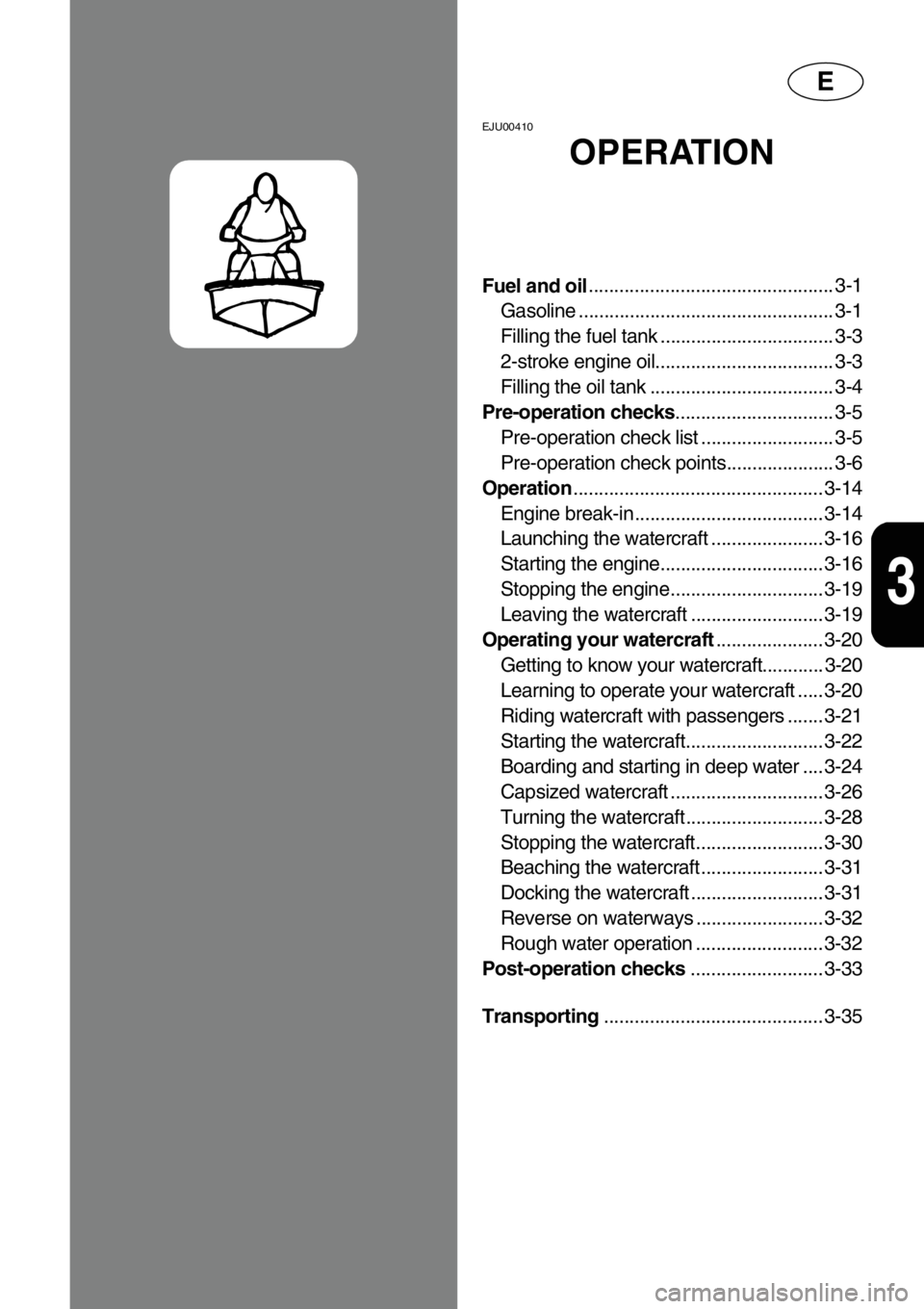
E
3
EJU00410
OPERATION
Fuel and oil................................................ 3-1
Gasoline .................................................. 3-1
Filling the fuel tank .................................. 3-3
2-stroke engine oil................................... 3-3
Filling the oil tank .................................... 3-4
Pre-operation checks............................... 3-5
Pre-operation check list .......................... 3-5
Pre-operation check points..................... 3-6
Operation................................................. 3-14
Engine break-in ..................................... 3-14
Launching the watercraft ...................... 3-16
Starting the engine................................ 3-16
Stopping the engine.............................. 3-19
Leaving the watercraft .......................... 3-19
Operating your watercraft..................... 3-20
Getting to know your watercraft............ 3-20
Learning to operate your watercraft ..... 3-20
Riding watercraft with passengers ....... 3-21
Starting the watercraft........................... 3-22
Boarding and starting in deep water .... 3-24
Capsized watercraft .............................. 3-26
Turning the watercraft........................... 3-28
Stopping the watercraft......................... 3-30
Beaching the watercraft ........................ 3-31
Docking the watercraft .......................... 3-31
Reverse on waterways ......................... 3-32
Rough water operation ......................... 3-32
Post-operation checks.......................... 3-33
Transporting........................................... 3-35
Page 58 of 131
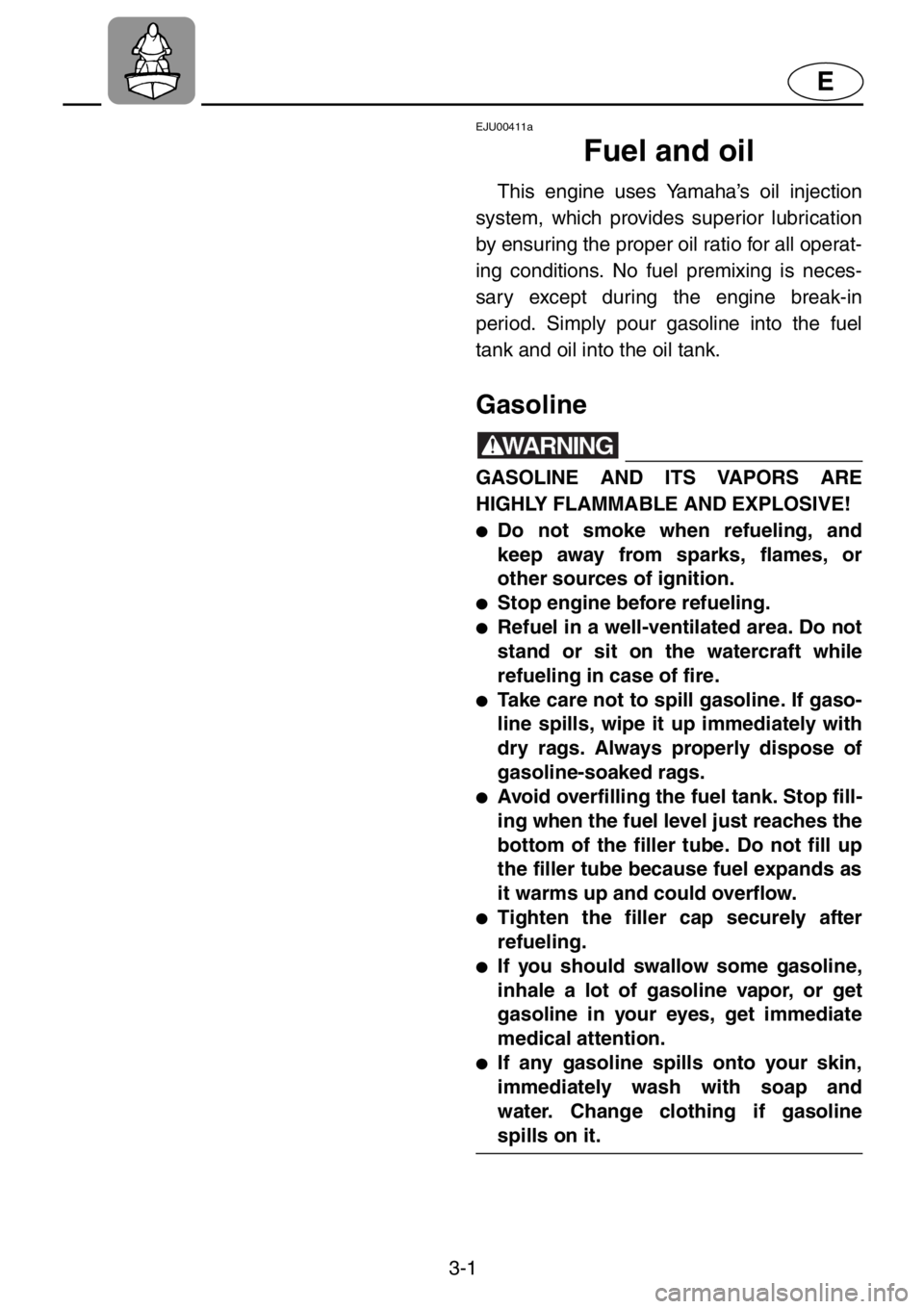
3-1
E
EJU00411a
Fuel and oil
This engine uses Yamaha’s oil injection
system, which provides superior lubrication
by ensuring the proper oil ratio for all operat-
ing conditions. No fuel premixing is neces-
sary except during the engine break-in
period. Simply pour gasoline into the fuel
tank and oil into the oil tank.
Gasoline
WARNING
GASOLINE AND ITS VAPORS ARE
HIGHLY FLAMMABLE AND EXPLOSIVE!
●Do not smoke when refueling, and
keep away from sparks, flames, or
other sources of ignition.
●Stop engine before refueling.
●Refuel in a well-ventilated area. Do not
stand or sit on the watercraft while
refueling in case of fire.
●Take care not to spill gasoline. If gaso-
line spills, wipe it up immediately with
dry rags. Always properly dispose of
gasoline-soaked rags.
●Avoid overfilling the fuel tank. Stop fill-
ing when the fuel level just reaches the
bottom of the filler tube. Do not fill up
the filler tube because fuel expands as
it warms up and could overflow.
●Tighten the filler cap securely after
refueling.
●If you should swallow some gasoline,
inhale a lot of gasoline vapor, or get
gasoline in your eyes, get immediate
medical attention.
●If any gasoline spills onto your skin,
immediately wash with soap and
water. Change clothing if gasoline
spills on it.
Page 59 of 131

3-2
E
CAUTION:
Use only fresh gasoline that has been
stored in clean containers.
Gasohol
There are two types of gasohol: gasohol
containing ethanol and that containing meth-
anol.
Gasohol containing ethanol can be used
if ethanol content does not exceed 10 % and
the fuel meets minimum octane ratings.
Gasohol containing methanol is not rec-
ommended by Yamaha because it can
cause fuel system damage or engine perfor-
mance problems.Recommended gasoline:
Regular unleaded gasoline with
a minimum octane rating of
86 (Pump octane number) = (R+M)/2
90 (Research octane number)
Page 60 of 131
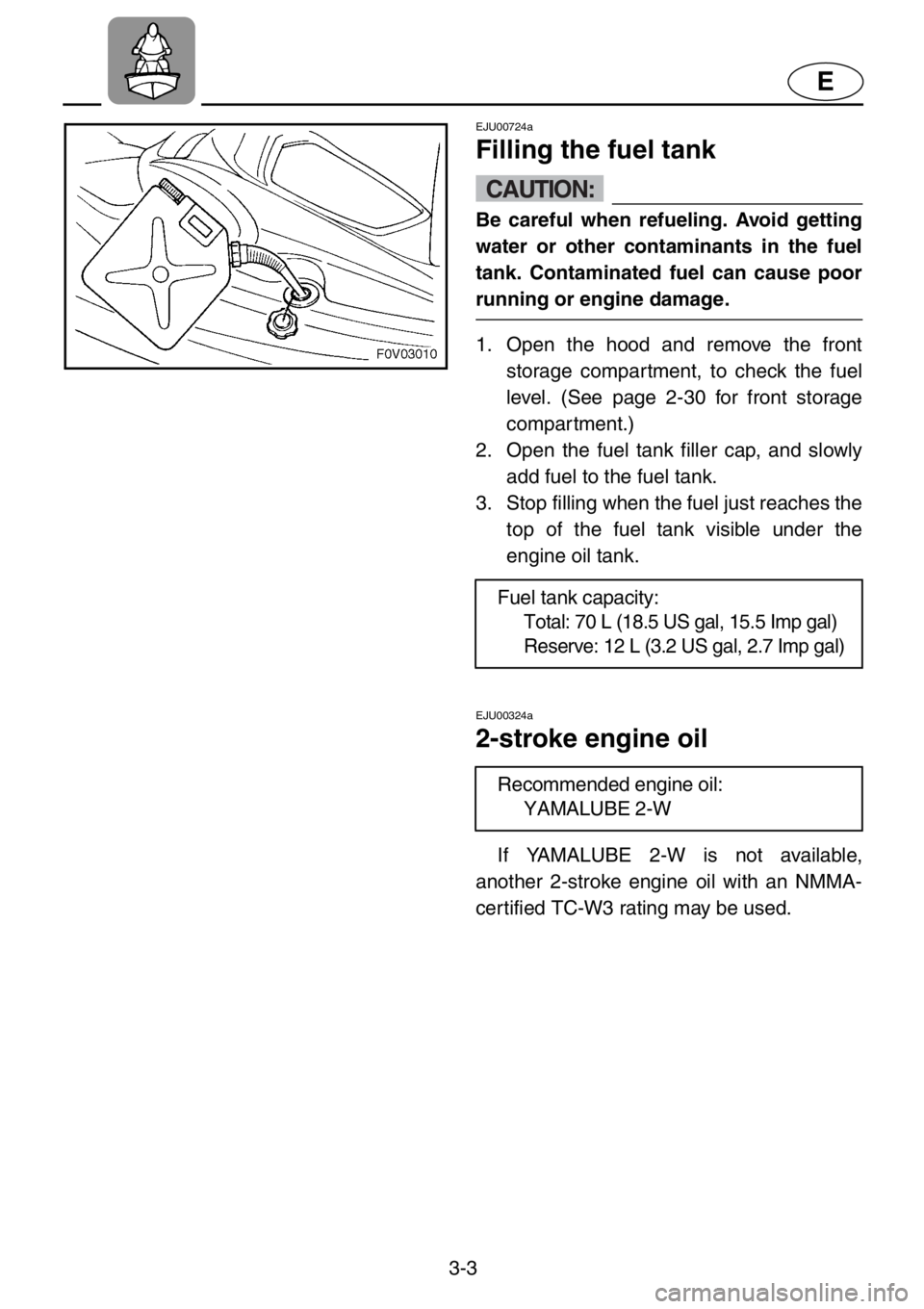
3-3
E
EJU00724a
Filling the fuel tank
CAUTION:
Be careful when refueling. Avoid getting
water or other contaminants in the fuel
tank. Contaminated fuel can cause poor
running or engine damage.
1. Open the hood and remove the front
storage compartment, to check the fuel
level. (See page 2-30 for front storage
compartment.)
2. Open the fuel tank filler cap, and slowly
add fuel to the fuel tank.
3. Stop filling when the fuel just reaches the
top of the fuel tank visible under the
engine oil tank.
EJU00324a
2-stroke engine oil
If YAMALUBE 2-W is not available,
another 2-stroke engine oil with an NMMA-
certified TC-W3 rating may be used.Fuel tank capacity:
Total: 70 L (18.5 US gal, 15.5 Imp gal)
Reserve: 12 L (3.2 US gal, 2.7 Imp gal)
Recommended engine oil:
YAMALUBE 2-W